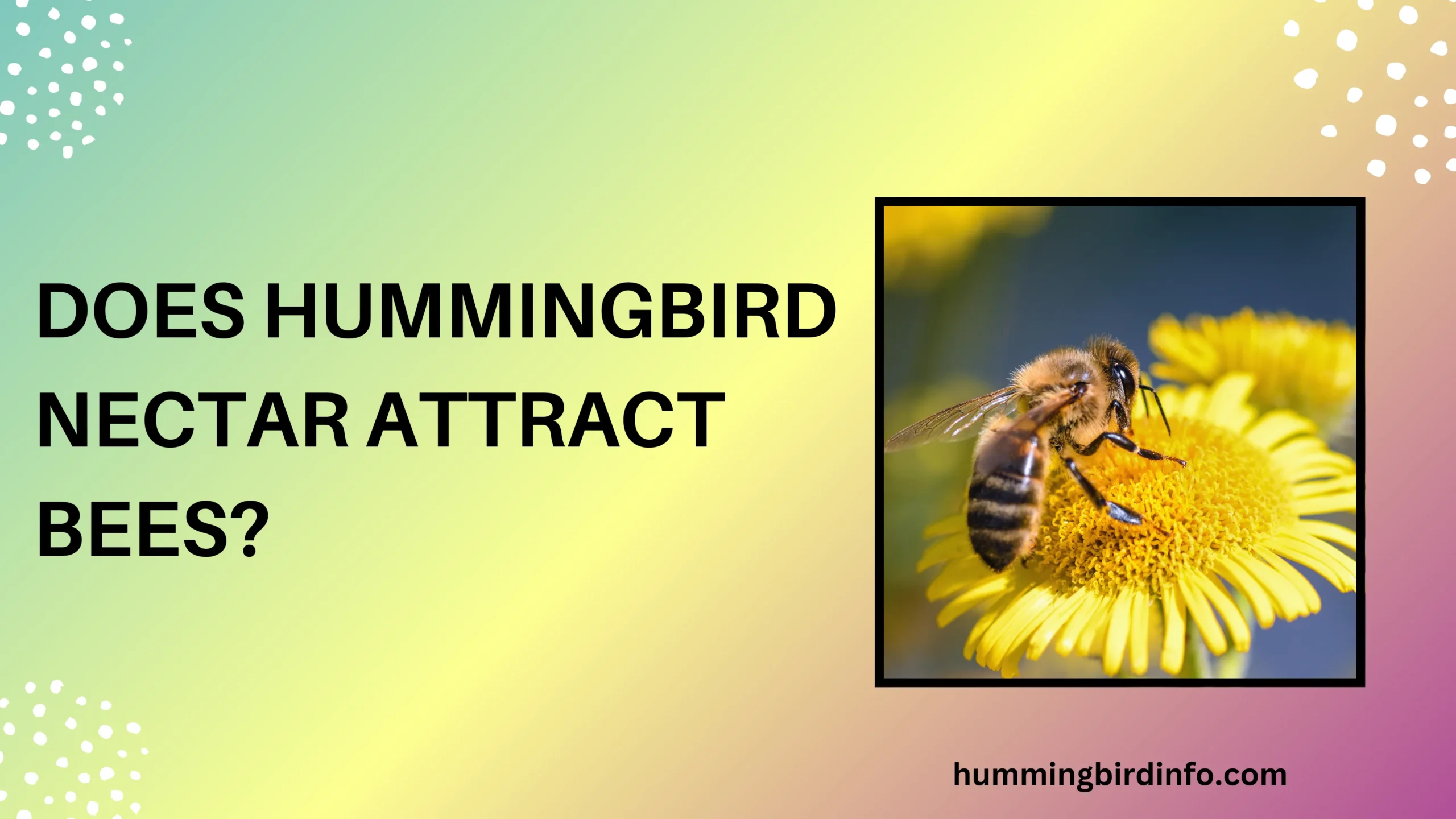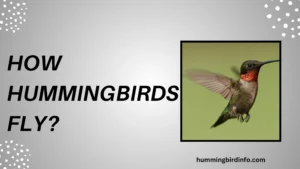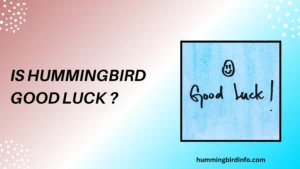Hummingbirds are nature’s living jewels—tiny, vibrant, and incredibly energetic. With their rapid wingbeats and ability to hover like helicopters, they’re a joy to watch. They zip from flower to flower, feeding on sweet nectar, a key source of energy that fuels their high-speed lives.
To attract these dazzling birds, many backyard enthusiasts set up hummingbird feeders filled with sugar water. But with these feeders often comes an unexpected guest—bees.
While bees are essential pollinators in their own right, their presence at feeders can turn a peaceful birdwatching experience into a buzzing battleground.
So, does hummingbird nectar really attract bees? And if so, why? This post dives deep into the shared love of sweetness between bees and hummingbirds, explores their different feeding styles, and offers practical solutions to help you enjoy both without the conflict.
If you’re tired of finding your feeder swarmed by bees, or just curious about what’s going on, keep reading—you’re about to uncover the full story.
Contents
- 1 The Allure of Nectar – Why Hummingbirds and Bees Both Love Sweetness
- 2 Hummingbird vs. Bee – Differences in Feeding Habits and Preferences
- 3 The Problem of Bees at Hummingbird Feeders
- 4 Keeping Bees Away – Strategies for a Hummingbird-Friendly Feeder
- 5 Creating a Harmonious Backyard – Supporting Both Hummingbirds and Bees
- 6 Conclusion
- 7 FAQs
- 8 1. Why are bees attracted to my hummingbird feeder?
- 9 2. Can bees harm hummingbirds at feeders?
- 10 3. How can I keep bees away from my hummingbird feeder?
- 11 4. What kind of flowers attract bees instead of hummingbirds?
- 12 5. Does moving the feeder help reduce bee problems?
- 13 6. Will red feeders attract fewer bees?
The Allure of Nectar – Why Hummingbirds and Bees Both Love Sweetness
Nectar is a sugar-rich liquid secreted by flowers, and it’s a powerful magnet for many creatures. For both hummingbirds and bees, it’s an essential energy source that powers their intense activity.
Hummingbirds need a constant fuel supply to maintain their fast wing movements and hovering. Their metabolism is so fast, they eat every 10 to 15 minutes during daylight hours.
Bees, on the other hand, use nectar to power flight, foraging, and even to make honey. They seek out sweet blooms to bring food back to the hive and sustain their colony.
The carbohydrates in nectar—primarily sucrose, glucose, and fructose—are what make it such a sought-after resource. Both birds and bees depend on these sugars to survive.
While flowers often evolve to attract one specific type of pollinator, there’s always some overlap. That’s why you’ll sometimes find both birds and bees at the same source.
Because of this shared interest, hummingbird feeders can quickly become a place of competition, especially when natural nectar sources are limited.

Hummingbird vs. Bee – Differences in Feeding Habits and Preferences
Hummingbirds are built for nectar. They have long, thin beaks and extendable tongues that allow them to reach deep into tubular flowers.
They hover while feeding, rarely landing, and usually sip from each flower for just a few seconds before moving on.
Bees, by contrast, often land on flowers and use shorter or longer tongues, depending on the species, to extract nectar. Some even chew into flowers to access hard-to-reach nectar.
While hummingbirds prefer bright red, tubular flowers, bees favor a variety of shapes and colors, often flowers with landing platforms.
Foraging behavior also differs. Hummingbirds move quickly and cover large areas, while bees often stick to one flower type per trip and may arrive in large groups.
In terms of taste, bees may prefer slightly more concentrated nectar, but both species are attracted to the basic sugar-water blend used in feeders.
The Problem of Bees at Hummingbird Feeders
When bees discover a hummingbird feeder, they often come in large numbers, making it hard for birds to approach.
Bees aren’t usually aggressive, but in the presence of limited resources, they can become territorial, deterring hummingbirds.
A bee swarm can drain a feeder quickly, leaving nothing for the hummingbirds and requiring you to refill more often.
Spilled nectar or leaky feeders attract bees even more and may lead to contamination from pollen, debris, or waste.
Hummingbirds are easily disturbed by buzzing insects, so a feeder full of bees can cause them stress and push them to seek food elsewhere.
For people who enjoy watching birds up close, the presence of bees can significantly reduce the joy of maintaining a hummingbird-friendly space.
Keeping Bees Away – Strategies for a Hummingbird-Friendly Feeder
The right feeder design can make all the difference. Bee guards—tiny mesh barriers—allow hummingbirds in while keeping bees out.
Saucer-style feeders keep the nectar level low, making it difficult for bees to reach, while still accessible to long-billed hummingbirds.
Opt for feeders with tiny feeding ports, which are too small for bees but perfect for hummingbirds’ slender bills.
Where you place your feeder matters. Bees prefer sunny spots, so placing feeders in shade can help reduce their interest.
Keep feeders away from flowering plants that bees love, and try moving them regularly to confuse foraging bees.
Keep feeders clean—spilled or fermented nectar attracts bees. Wipe feeders and check for leaks that may draw insects.
Use the correct nectar ratio of 1 part sugar to 4 parts water. A stronger mix may attract more bees.
Never add red dyes or unnecessary additives—these are harmful to birds and won’t deter bees. Stick with clear nectar.
Attract bees elsewhere with bee-friendly flowers like lavender, marigolds, or borage. Give them a water source like a shallow dish with stones to perch on.

Creating a Harmonious Backyard – Supporting Both Hummingbirds and Bees
Both hummingbirds and bees are important pollinators and play a major role in a healthy garden ecosystem.
Creating a balanced space allows you to support both without unnecessary conflict—each has its own niche to fill.
Use native plants and a wide variety of blooms to keep everyone happy—different shapes, colors, and blooming times matter.
Separate feeding zones: Keep hummingbird feeders in one area and plant bee-attracting flowers in another to reduce overlap.
Avoid pesticides and chemicals that harm both bees and birds. These natural creatures thrive best in a chemical-free yard.
Taking care of both ensures your garden is buzzing and fluttering with life, all season long.
Conclusion
Hummingbird nectar does attract bees—that much is true. Both creatures are drawn to the sweet sugar solution that mimics the nectar found in flowers.
But with a little strategy, you can manage the presence of bees and still keep your feeder hummingbird-friendly. From using bee-proof feeders to strategic placement and clean maintenance, it’s all about the right balance.
Ultimately, your backyard can be a haven for both birds and bees. Supporting both means helping biodiversity and enjoying a richer, more vibrant natural space. It’s not about choosing one over the other—it’s about learning how to share the sweetness.
FAQs
1. Why are bees attracted to my hummingbird feeder?
Bees are drawn to the sugar water in hummingbird feeders because it mimics the nectar they gather from flowers.
2. Can bees harm hummingbirds at feeders?
Bees typically don’t harm hummingbirds, but they can intimidate them and prevent access to feeders by crowding or being aggressive.
3. How can I keep bees away from my hummingbird feeder?
Use bee guards, saucer-style feeders, place the feeder in shade, and keep it clean to reduce bee visits.
4. What kind of flowers attract bees instead of hummingbirds?
Bees love lavender, sunflowers, borage, and marigolds. Plant these to offer alternative nectar sources.
5. Does moving the feeder help reduce bee problems?
Yes, moving the feeder a few feet every few days can confuse foraging bees, making it harder for them to find it again.
6. Will red feeders attract fewer bees?
Not necessarily. Bees can still detect feeders by scent and leaked nectar, even if the color isn’t ideal for them.








